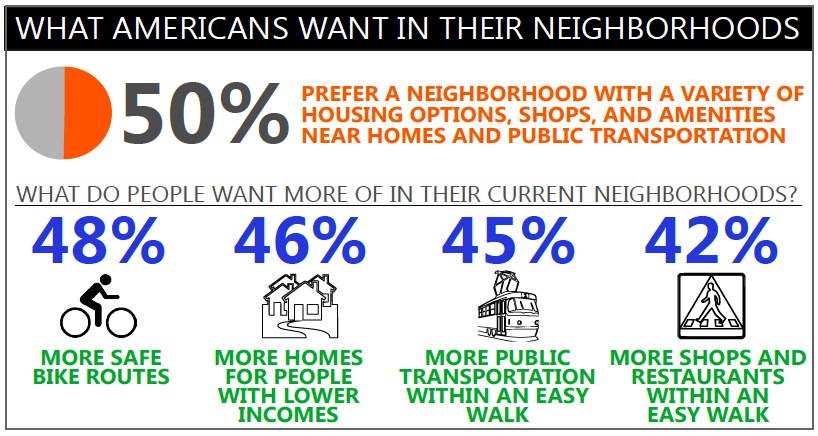PARTNERSHIP FOR SUSTAINABLE COMMUNITIES
What Are Sustainable Communities?
Sustainable communities have a variety of housing options, with homes near workplaces, schools, parks, stores, and amenities. Having these daily destinations close together allows people to walk, bike, take transit, or drive short distances, which can save them money while reducing pollution from vehicles. In sustainable communities, people can live closer to jobs or have easier access to more jobs in a wider region. This diversity of travel, housing, and employment options helps make communities more affordable, environmentally sustainable, and economically resilient. Rural, suburban, and urban places can all use sustainable communities strategies to create healthy, safe, walkable neighborhoods.
Introduction
Interagency collaboration through the Partnership for Sustainable Communities invests taxpayer money more efficiently and gets better results for communities. By sharing knowledge and coordinating investments in infrastructure, facilities, and services, the U.S. Department of Housing and Urban Development (HUD), U.S. Department of Transportation (DOT), and U.S. Environmental Protection Agency (EPA) can meet multiple economic, environmental, and community objectives with each dollar spent.
Since 2009, HUD, DOT, and EPA have collaborated to ensure their policies and investments better serve American communities. Through these efforts, more than 1,000 communities in all 50 states, Washington, D.C., and Puerto Rico have received more than $4 billion in grants and technical assistance to help them grow and improve their quality of life.
This publication summarizes some significant policy changes and collaborations and how they have made a difference in communities over the past five years. The Partnership’s work has driven not only HUD, DOT, and EPA, but also other federal agencies to make lasting policy changes that will use resources more effectively and improve how agencies work with communities for years to come. The publication also looks at critical issues facing our nation in the future and how the Partnership can help communities take advantage of opportunities and overcome challenges.
Many of our communities and housing options, built for a different time, are not what Americans want today. Research from the real estate industry shows that more people want to live in more convenient, walkable neighborhoods (Figure 1). A National Association of Realtors survey showed that half of Americans prefer a neighborhood with a variety of housing types, including multifamily and single-family homes; shops, restaurants, and amenities within walking distance; and nearby public transportation over a neighborhood with only single-family homes and few transportation options besides driving. Walkable communities are particularly important to millennials, who make up the largest percentage of the U.S. population; one research firm estimates that about 70 percent of them see walkability as “important” or “vital” when choosing a home.
Since 2000, Americans have seen their combined costs for housing and transportation grow faster than household income (Figure 2). This trend disproportionately affects households at or below median income. Housing and transportation costs combined account for nearly half of total income for median-income households and an even greater share for moderate-income (between 50 to 100 percent of median income) households (Figure 3).
The complex challenges in many struggling communities need comprehensive, integrated solutions. Safe, decent, and affordable housing; reliable transportation options; and a clean, healthy environment are fundamental to a person’s ability to lift him- or herself into a better life. These resources are rungs on the “ladders of opportunity” that help lower-income Americans reach the middle class. The Partnership’s work supports these ladders of opportunity in many ways. Making sure that low-income people have access to reliable and affordable transportation options lets them reach more education and job opportunities and gives businesses a larger pool of workers. Encouraging investment and revitalization in underserved neighborhoods can bring new, affordable homes while creating jobs constructing or repairing buildings and infrastructure. The community-driven solutions that Partnership investments support can help address environmental justice and social equity issues by giving everyone, including traditionally underrepresented groups, the chance to get involved in identifying environmental, economic, and social challenges; crafting a vision for the future; and implementing fair solutions.
About the Partnership for Sustainable Communities
www.sustainablecommunities.gov
The Partnership for Sustainable Communities works to coordinate federal housing, transportation, water, and other infrastructure investments to make neighborhoods more prosperous, allow people to live closer to jobs, save households time and money, and reduce pollution. The partnership agencies incorporate six principles of livability into federal funding programs, policies, and future legislative proposals.
Tags: Department of Housing and Urban Development, HUD, Partnership for Sustainable Communities







 RSS Feed
RSS Feed